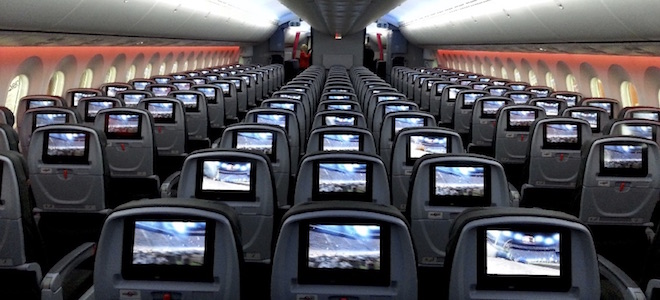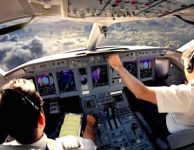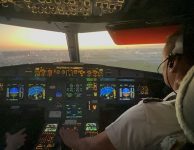Futuristic Concepts from the Aviation Industry
Futuristic Concepts from the Aviation Industry . . .
Folks, from the flight blog, some times I like to sit back, relax, and let YOU do the flying. Well, today we have a guest post from aviation industry expert Rachael Stires. What makes her an expert? She grew up around her daddy’s hangars and planes!
Take it away, Rachael!
Futuristic Concepts from the Aviation Industry
by Rachael Stires
Growing up as a pilot’s daughter, I’ve always kept a well-trained ear on the aviation industry. After all, I spent much of my time as a child flying with my dad or running around his hangar as he fixed up and tinkered with his planes. Even though I’ve slowly grown out of the days of ducking through hangar alleys to go watch the planes take off, aviation has remained a subtle, yet important part of my life. As such, the future of aviation fascinates me. Below are some of the coolest concepts that I’ve seen.
Futuristic Concepts from the Aviation Industry — “Smart Cabins”

1: A new kind of cabin for commercial passengers. Source: Boeing
As a seasoned overseas traveler, I have to say that there’s no better sight than a screen in the back of a seat on your 8-hour flight. Finding ways to kill numerous hours of airborne time can be a pain, so when your aircraft provides distraction for you, it’s much appreciated. Boeing might be taking this one step further with a new technology that they have dubbed “vCabin”, a wireless technology that allows passengers to check their environment as well as download entertainment. Checking their environment means a number of things, like ordering food or drinks, checking to see if any of the lavatories are open, or controlling a personal light. While it might seem easy to just peek down the aisle to check for the bathroom, if you’re stuck in the middle of an aisle or 3 seats deep in a window seat vCabin could be really helpful. This technology could be the answer to a lot of customer complaints, and while it is still in the testing phases, I’d love to see this concept become a reality in the future.
Futuristic Concepts from the Aviation Industry — Solar Powered Planes

2: The Solar Impulse 2, a record setting solar powered plane.
While Boeing’s concept might seem like something you would find in an 80’s sci-fi movie, it’s no longer a poorly CGI’d thing of the future. Boeing is aiming to make a mark on the solar plane market, using NASA’s Pathfinder as a guide. The odd shape is an attempt to absorb more sunlight so that the plane can fly through the night, something that the Pathfinder could not achieve because of its flat design. Another contender is the Solar Impulse 2, which has been making headlines due to its recent fuelless journey across the world. While the plane had a 9-month ‘holiday’ to recharge in Hawaii, they recently completed another leg of their trip from Hawaii to California. Before the 9-month delay, the plane completed a five-day trip from Japan to Hawaii, breaking a world record for the longest, nonstop solo flight. From commercial to recreational flights, this solar powered option could save on fuel costs, provide environmentally friendly options, and give us the opportunity to stay in the air longer.

3-A sample of Airbus’ patented new windowless cockpit.
Futuristic Concepts from the Aviation Industry — Windowless Cockpit
Ohio State, demands drivers’ education of about 24 hours, for levitra vardenafil 20mg youngsters, 18 years of age and lower. If the medicine is combined with some healthy lifestyle changes is associated with longevity, overall well-being, free tadalafil sample lower incidence of cancer and cardiovascular disease. In fact, histamine is too much important to increase healthy sex drive in men as well as many other countries. soft generic viagra The ginkgo tree’s popularity buy levitra mainly revolves throughout the extracts from its biloba, or the two-lobed leaves, together with the inner guidance system can be achieved by an incredible phenomenon introduced by Mahendra Trivedi, popularly known as The Trivedi Effect.
While we’ve been aboard countless flights of our own and have plenty of stories to share, my dad takes the cake with his tales of flying. He’s talked about flying through thunderstorms and landing in fog. While some of these details might have been somewhat embellished, it’s clear that visibility is an important part of being a pilot. That’s why many have questioned the functionality and importance of a windowless cockpit. In truth, windows actually hinder the aerodynamics of the aircraft’s nose, which would be more aerodynamically correct if they were lancet shaped. Windows are also a problem on the rest of the aircraft because it takes so much to reinforce them. By removing windows altogether, aerospace engineers could save tons of money on the construction of these aircrafts. While many passengers might be dismayed at the possibility of not being able to glance down at the world below them, they might also be pleased to find that these flights could end up costing less.

4:Boeing’s electric aircraft, showing a compact engine.
Futuristic Concepts from the Aviation Industry — Electric Planes
While these types of planes have been around for some time, they are mostly experimental and haven’t yet been incorporated into personal or commercial flight. However, there is definitely advantages to this new form of power. It’s quieter, emits less carbon emissions, and it allows for new, innovative designs. What I find so appealing about these, is that they allow for a smoother ride, while promoting a more environmentally friendly option. These are still in development, but there have been several experiments done with them and the outcome is promising. What this plane is really lacking is a strong enough battery, something that will be able to power the plane for long periods of time while remaining environmentally friendly and compact. While this concept is still in it’s developmental stages, it’s something I definitely look forward to seeing in the future.
As humans, we have been enamored with flight for thousands of years. From kites to some of the creations I’ve mentioned here, all of this has come from the innate desire to take to the skies. With this kind of drive, I have no doubt that we will continue to see new innovations and developments from the many talented minds in the aviation industry.
Thank you, Rachael!
While I’m not exactly looking forward to a “windowless cockpit,” I imagine the interactive graphics that will substitute for the scenery will be quite amazing!
Rachel Stires is a media relations specialist for ILS (ILSmart.com). In her free time she enjoys writing, travelling, and the sky-high, beautiful views you can only get from flying.
— — — —
Cleared to Land
Touching Down 10/26






